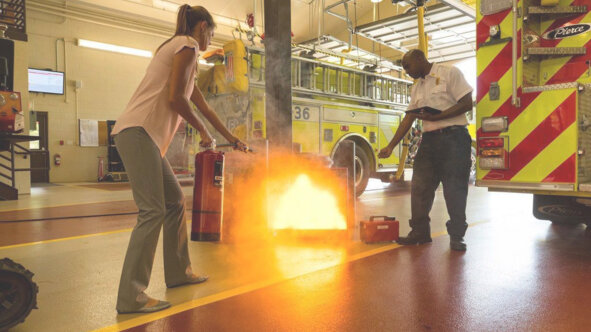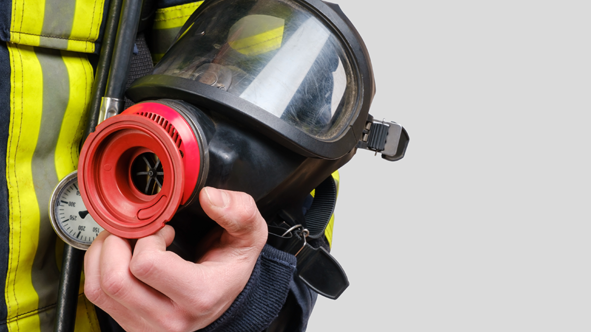Why?
Working inside a storage tank, crawlspace or industrial chimney is associated with risks. Enclosed spaces are often difficult to access and poorly lit or ventilated. When a fire breaks out, life-threatening situations emerge.
That is why it is so important to recognise the risks and understand how to prevent them.
This course complies with B-VCA1 and VOL-VCA2 and is suitable as a foundation for the exam.
1* B-VCA or safety basics VCA is a certificate for employees in (petro)chemistry, electrical engineering, construction, transportation and more. VCA stands for Health, Safety and Environment Checklist Contractors
2* VOL-VCA stands for VGM Checklist Contractors - Safety for operational management. Are you a supervisor in a high-risk environment? Or does your team engage in high-risk activities? The VOL-VCA certificate is a statutory requirement for you. It serves to prove that you are able to safeguard the safety of your team.
What do you learn?
During this course you will learn:
- How to enter enclosed spaces safely
- How to correctly estimate the danger for each space
- Knowledge about evacuation techniques with the necessary aids
- How to use the right measuring equipment correctly
- How to apply preventive measures
- How to use personal protective equipment correctly
This course serves a maximum of 12 participants. This leaves plenty of opportunity for interaction and practice and you will get to implement your newly gained knowledge right away.
This course is part of our Increase-offer

Increase your knowledge or get a refresher on a particular subject. In this way you strengthen your practical skills. The courses can be either digital or classroom-based.
Result?
After this course:
- You understand the hazards of an enclosed space
- You know how to act safely in the event of danger in an enclosed space
After the course, you will receive a certificate of participation. There is no exam or test, the teacher will guide you where necessary.
This course complies with VCA-basis and VCA-VOL and is suitable as a foundation for the exam.
Learn the basics of fire prevention and firefighting
If you don’t have any basic knowledge yet, we recommend the ‘Fire prevention and control’ course.
For whom?
The course is suitable if you work in spaces
- That are not intended for continuous use, such as sewage systems, crawlspaces, ditches with piping and storage tanks
- That are difficult to access
- That are insufficiently lit
- With little or no ventilation
- Where the air is usually humid
- With a hazardous atmosphere (intoxication, fire, explosion or suffocation)
What does the law say?
Do you work in an enclosed space on occasion? The law requires a valid work permit. It is important that the space is empty before commencing your work. Are any hazardous gases, such as CO or natural gas stored there? The law requires that they are removed first.
Price
The price depends on how you follow the training.
If your organisation is affiliated with Mensura External Service for Prevention and Protection at Work (ESPPW) and you have prevention units, you can pay with these as long as your balance is sufficient.
Your organisation can request the courses to be conducted in the evening or over the weekend at a surcharge. Are you interested? Please indicate this in your quotation request.
Subsidies and financing options
We qualify for all kinds of subsidies and financing options because we are certified by many government agencies and sector funds.
- SME portfolio (in Flanders). Use these certification numbers in your application:
- members of Mensura External Department for Prevention and Protection: Mensura EDPB - DV.O105072
- non-members: Mensura CONSULT - DV.O101943
- Training vouchers
- Sector fund
- Alimento
- Constructiv
Frequently Asked Questions
Is having a firefighting service mandatory?
Yes. Every employer must organise its own firefighting service.
This service consists of several employees who act efficiently in the event of a fire hazard. It is irrelevant how many employees you have. One person in the service must always be present.
A risk analysis determines how many employees the firefighting service must engage. This depends on your company size, type of business operations, and the fire risk.
Who should receive fire training in my organisation?
Every organisation must have several employees that act efficiently in the event of a fire hazard, i.e. the firefighting service. The team members take a specific course that has both theoretical and a practical elements. They learn to participate in a risk analysis, intervene when a fire starts, and carry out an evacuation correctly and quickly.
All other employees must be informed about possible fire risks, the alarm signal, what to do in case of fire, and how to evacuate.





